Vimar ELVOX 1222/35 Handleiding
Vimar
Niet gecategoriseerd
ELVOX 1222/35
Bekijk gratis de handleiding van Vimar ELVOX 1222/35 (18 pagina’s), behorend tot de categorie Niet gecategoriseerd. Deze gids werd als nuttig beoordeeld door 21 mensen en kreeg gemiddeld 4.7 sterren uit 11 reviews. Heb je een vraag over Vimar ELVOX 1222/35 of wil je andere gebruikers van dit product iets vragen? Stel een vraag
Pagina 1/18

1200
Targhe citofoniche/videocitofoniche Serie 1200
1200 Series interphone/video door entry system entrance panels
Platines parlophoniques/visiophoniques Série 1200
Haustelefon-/Videohaustelefon-Klingeltableaus Serie 1200
Placas para portero automático/videoportero serie 1200
Botoneiras para porteiro automático/videoporteiro série 1200
Μπουτονιέρων θυροτηλέφωνου/θυροτηλεόρασης σειράς 1200
Manuale installatore - Installer guide
Manuel installateur - Technisches Handbuch
Instrucciones instalador - Manual do instalador
Εγχειρίδιο οδηγιών

EN
The instruction manual is downloadable from the site
www.vimar.com
Technical specications
1200 Series Entrance Panels:
• Cover plate made of AISI 316 stainless steel (4VA) 8/10
thick, with embossed surface (stainless steel) or with PVD
treatment (gold effect)
• Can be wall-mounted or ush-mounted with relevant ac-
cessories
• IK10-rated for protection against impact (except for Audio/
Video cover plates for alphanumeric electronic units and
related additional plates with name cards for alphanumer-
ic electronic units).
• Protection class: IP44
• Die-cast aluminium heads (that enable fixing the front plate
to the frame with a special ELVOX screw)
• Support for transparent shockproof polycarbonate buttons
• Stainless steel frame.
• Transparent polycarbonate buttons covered with stainless
steel protection
Reinforced 1200 Series Entrance Panels:
• Cover plate made of AISI 316 stainless steel (4VA) 8/10
thick, with weatherproof satin nish (sable grey) paint
treatment also for installation in saline environments.
• Can be ush-mounted with relevant accessories
• IK10-rated for protection against impact (except for Audio/
Video cover plates for alphanumeric electronic units and
related additional plates with name cards for alphanumer-
ic electronic units).
• Protection class: IP44
• Die-cast aluminium heads (that enable fixing the front plate
to the frame with a special ELVOX screw)
• Support for transparent shockproof polycarbonate buttons
• Stainless steel frame.
• Transparent polycarbonate buttons covered with stainless
steel protection
The items in the 1200 series enable making entrance
panels for audio and video door entry systems with the
technology of:
- Elvox Due Fili
- Digibus
- Sound System or C.A. call
The entrance panels are supplied with a front plate and a
frame and are comprehensive of electronics and related add-
ons supplied separately to be selected depending on the type
of plant (Elvox ue Fili, Digibus, Sound System, c.a. call) and D
the type of installation.
The instructions refer to mounting the entrance panel only.
For complete installation, connection and programming (for
electronic panels), please refer to the manual of the electronic
unit, camera or speech unit to be added:
For the DUE FILI system:
- Push-button electronic unit: 13F3 (audio), 13F5 (video)
- Electronic unit with alphanumeric keypad: 13F4 (audio),
13F7 (video)
- Audio speech unit: 6931.
For the DIGIBUS system:
- Push-button electronic unit: 1283 (audio), 1285 (video)
- Electronic unit with alphanumeric keypad: 1282 (audio),
1286 (video)
For the or . system: Sound System C.A
- Audio speech units: Art. 930A, 930C, 930D, 930F, 930G.
- Camera with Speech Unit: Art. 559A, 559B, 560A.
Additional components for Due Fili and Digibus
systems
The entrance panel is supplied ready for video door entry
systems and is to be implemented with the following items:
- Flush-mounted back box art. 9192 for entrance panels in
2 vertical modules or art. 9193 for entrance panels in 3
vertical modules.
Note: Back boxes 9192 and 9193 cannot be matched with
each other but only as follows: 9192 with 9192 or 9193
with 9193.
- Rainproof covers art. 1P21, 1P22, 1P23, 1P24 for en-
trance panels in 2 vertical modules or 1P31, 1P32, 1P33,
1P34 for entrance panels in 3 vertical modules
- Surface-mounted boxes with rainproof cover art. 1E21,
1E22, 1E23, 1E24 for entrance panels in 2 vertical mod-
ules or 1E31, 1E32, 1E33, 1E34 for entrance panels in 3
vertical modules.
- Push-button audio electronic unit Art. 13F3 (Due Fili) or
Art. 1283 (Digibus)
- Alphanumeric audio electronic unit Art. 13F4 (Due Fili) or
Art. 1282 (Digibus)
- Push-button video electronic unit Art. 13F5 (Due Fili) or
Art. 1285 (Digibus)
- Alphanumeric video electronic unit Art. 13F7 (Due Fili) or
Art. 1286 (Digibus)
- Additional module with buttons: Art. 12TS with 4 buttons
(for entrance panels with a single row of keys) or Art. 12TD
with 8 buttons (for entrance panels with two rows of keys).
The same entrance panel can be preset for the audio elec-
tronic unit, in which case you need to remove the ring from
the back of the front plate, marked with number 1 in figure 6,
and in its place insert the cover for closing the lens, marked
with number 2 in figure 6, on the frame (B).
Additional components for Sound System and
C.A. call systems:
The entrance panel is preset for video entrance panel sys-
tems and is to be implemented with the following articles:
- Flush-mounted back box type 9192 for entrance panels in
2 vertical modules or type 9193 for entrance panels in 3
vertical modules.
Note: Back boxes type 9192 or 9193 cannot be matched
between them but only between: 9192 with 9192 or 9193
with 9193
- Video camera with speech unit type 559A or 559B or 560A
or speech unit type 930A, 930B, 930C, 930D, 930F or Art.
930G (fig. 1 shows how to insert the camera in the frame).
- Push-buttons type R200, R200/50 (R200/50 = package
with 50 push-buttons R200)
- LED for lighting name-tags type R260
- Diodes type 0002/994 (for “1+N wires” or without coaxial
cable).
- Rainproof covers type 1P21, 1P22, 1P23, 1P24 for en-
trance panels in 2 vertical modules or 1P31, 1P32, 1P33,
1P34 for entrance panels in 3 vertical modules
- Surface-mounted boxes with rainproof cover type 1E21,
1E22, 1E23, 1E24 for entrance panels in 2 vertical mod-
ules or 1E31, 1E32, 1E33, 1E34 for entrance panels in 3
vertical modules.
The same entrance panel can be preset for the sole external
speech unit; in this case remove the ring from the back of the
front plate (identified with number 1 in fig. 6); insert in its place
the cover for closing the lens (shown with number 2 in fig. 6)
in the frame “ ”, install the bracket “ ” (using the screws supB C -
plied) for the speech unit (see fig. 20, 22, 24).
Installing 1200 series panels in Due Fili or
Digibus systems.
- Install the flush-mounting back box or the surface-(N)
mounting back box on the wall at a height of approx. (P)
1.65m from the top edge of the box to the ground.
Note: The 1200 series panels can be expanded only hori-
zontally with supplementary entrance panels. In the case
of flush-mounting, the boxes are to be coupled using the
hooks supplied with the boxes (see Fig. 30).
- Secure the terminal block of the electronic unit under the
module holder frame with the screws provided.
- When flush-mounting on a wall:
- Secure the rainproof cover if applicable, to the flush-(O),
mounting box (N).
- Secure the frame to the flush-mounting box or to (B) (N)
the rainproof cover.
When surface-mounting on a wall:
- Secure the frame (B) to the surface-mounting back
box.
- Connect the terminal block of the electronic unit to the sys-
tem, following the wiring diagrams in the reference manual
depending on the type of system.
- Connect the electronic unit to the terminal block (S, T/U, V)
with the wiring in the top.
- Connect any additional modules used (fig. 31B, 31C).
They should be connected one after the other by means of
the wiring supplied with the modules, and finally connected
to the standard electronic unit by means of the wiring in its
lower section.
The connection of more than one additional module
may necessitate the use of an additional power supply
unit art. 6582 to power the LEDs lighting the signs.
- Insert the electronic unit and any additional modules in
the frames (for the additional modules Art. 12TS of push-
button entrance panels, use the insert supplied to hold
them together, see Fig. 31B).
- Insert the microphone into the seat over the frame in (B)
the lower right side, closing the cap, as shown in fig. 7
detail 1.
Note: On the electronic units for Digibus systems it is nec-
essary to take out or cut the rubber cap (existing on audio
speech units or cameras), taking care not to cut the wires
of the microphone (see fig.7).
- Do the programming, referring to the manual of the elec-
tronic unit.
- For audio door entry systems, on the back of the front plate
you need to take out the lens ring and insert the cover (E)
for closing the lens (see fig. 6).(D)
- Shut the entrance panel, fixing it to the frame using the
special key “P” supplied (see fig. 8).
Installing the 1200 series panels in systems
with an audio speech unit or camera with a
speech unit (Sound System or c.a. systems)
Installing flush-mounting entrance panels on a
wall
- Install the flush-mounting back box on the wall at a (N)
height of approx. 1.65m from the top edge of the box to
the ground
Note: The 1200 series panels can be expanded only hori
-
zontally with additional panels, joining the flush-mounting
back boxes with the hooks supplied with the boxes (see
Fig. 30).
- In the case of audio door entry systems: secure the
bracket (C) at the top of the frame (B) with the screws in
the ready-made holes and secure the speech unit to the
bracket (see fig.20, 22)
- In the case of video door entry systems: secure the cam-
era (M) to the frame as shown in fig. 1, 21, 23 (B)
- Insert the microphone into the seat over the frame (B)
closing the cap, as shown in fig. 7 detail 1.
- Secure the push-buttons to the frame as shown in (G) (B)
fig. 20, 21, 22, 23
- Secure the card for LED lighting in its seat as shown in (H)
fig. 20, 21, 22, 23
- Secure the rainproof cover to the flush-mounting box(O)
- Secure the frame to the flush-mounting box or to the rain-
proof cover
- For audio door entry systems, on the back of the front plate
you need to take out the lens ring and insert the cover “E”
for closing the lens (see fig. 6)“D”
- Connect the speech unit or the camera, push-buttons and
LED card to the system, following the wiring diagrams in
the reference manual depending on the type of system.
- Close the entrance panel, securing it to the frame with the
aid of a screwdriver (see fig. 8).
Installing surface-mounting entrance panels on
a wall
- Install the surface-mounting back box on the wall at a (P)
height of approx. 1.65m from the top edge of the box to the
ground.
Note: The 1200 series panels can be expanded only hori
-
zontally with supplementary entrance panels.
- In the case of audio door entry systems: secure the
bracket (C) at the top of the frame (B) with the screws in
the ready-made holes and secure the speech unit to the
bracket (see fig. 24)
- In the case of video door entry systems: secure the cam-
era (M) to the frame as shown in fig. 1, 25. (B)
- Insert the microphone into the seat over the frame (B)
closing the cap, as shown in fig. 7 detail 1.
- Secure the frame to the surface-mounting back box
- Secure the card for LED lighting in its seat as shown in (H)
fig. 24, 25
- For entrance panels with only an audio speech unit, on the
back of the front plate you need to take out the lens ring
“E” “D” and insert the cover for closing the lens (see fig.
6)
- Connect the speech unit or the camera, push-buttons and
LED card to the system, following the wiring diagrams in
the reference manual depending on the type of system.
- Shut the entrance panel, fixing it to the frame using the
special key “P” supplied (see fig. 8).
3
1200

FR
Télécharger le manuel d’instructions sur le site www.
vimar.com
Caractéristiques techniques
Platines de rue série 1200 :
• Platine en acier inox aisi 316 (4VA), épaisseur 8/10, sur-
face gaufrée (acier inox) ou traitée PVD (effet doré)
• À encastrer ou à monter en saillie avec les accessoires
correspondants
• Indice de protection contre les impacts IK10 (à l’exception
des platines audio/vidéo pour unité électronique alpha-
numérique et des platines supplémentaires correspon-
dantes, avec pancartes porte-noms pour unité électro-
nique alphanumérique).
• Degré de protection IP44
• Têtes en aluminium moulés sous pression (qui permettent
une xation de la façade au châssis au moyen d’une vis
spéciale ELVOX)
• Support pour les touches en polycarbonate antichoc
transparent
• Châssis en acier inox.
• Touches en polycarbonate transparent recouvertes avec
une protection en acier inox.
Platines de rue série 1200 renforcées :
• Platine en acier inox aisi 316 (4VA). épaisseur 8/10, pein-
ture satinée (gris sablé) résistant aux agents atmosphé-
riques et pour installations en milieux salins.
• À encastrer avec les accessoires correspondants
• Indice de protection contre les impacts IK10 (à l’exception
des platines audio/vidéo pour unité électronique alpha-
numérique et des platines supplémentaires correspon-
dantes, avec pancartes porte-noms pour unité électro-
nique alphanumérique).
• Degré de protection IP44
• Têtes en aluminium moulés sous pression (qui permettent
une fixation de la façade au châssis au moyen d’une vis
spéciale ELVOX)
• Support pour les touches en polycarbonate antichoc trans-
parent
• Châssis en acier inox.
• Touches en polycarbonate transparent recouvertes avec
une protection en acier inox.
Les éléments de la série 1200 permettent de composer
des plaques pour circuits portiers et portiers-vidéo avec
technologie :
- Due Fili Elvox
- Digibus
- Appel Sound System ou c.a.
Les plaques sont dotées d’une platine frontale et d’un châssis
et doivent être complétées avec l’électronique et les com-
posants supplémentaires correspondants fournis à part, à
choisir en fonction du type de circuit ( ue Fili Elvox, Digibus, D
Sound System, appel c.a.) et du type d’installation.
La consigne concerne uniquement le montage de la plaque.
Pour l’installation complète, la connexion et la programma-
tion (pour plaques électroniques), faire référence au manuel
de l’unité électronique, de la caméra ou du poste externe à
insérer :
Pour système DUE FILI :
- Unité électronique à boutons : 13F3 (audio), 13F5
(vidéo)
- Unité électronique avec clavier alphanumérique : 13F4
(audio), 13F7 (vidéo)
- Poste externe audio : 6931.
Pour système DIGIBUS :
- Unité électronique à boutons : 1283 (audio), 1285
(vidéo)
- Unité électronique avec clavier alphanumérique : 1282
(audio), 1286 (vidéo)
Pour système ou . : Sound System C.A
- Postes externes audio : Art. 930A, 930C, 930D, 930F,
930G.
- Caméra avec Poste externe : Art. 559A, 559B, 560A.
Composants supplémentaires pour circuits Due
Fili et Digibus
La pla accepter l’installation de circuits que est conçue pour
portiers-vidéo et être complétée avec les articles suivants :
- Boîte d’encastrement murale art. 9192 pour plaques en 2
modules verticaux ou art. 9193 pour plaques en 3 modules
verticaux.
Remarque : Les boîtes 9192 ou 9193 ne peuvent pas être
accouplées entre elles mais uniquement de la façon sui-
vante : 9192 avec 9192 ou 9193 avec 9193.
- Cadres anti-pluie art. 1P21, 1P22, 1P23, 1P24 pour
plaques sur 2 modules verticaux ou 1P31, 1P32, 1P33,
1P34 pour plaques sur 3 modules verticaux
- Boîtes extérieures avec anti-pluie art. 1E21, 1E22, 1E23,
1E24 pour plaques en 2 modules verticaux ou 1E31,
1E32, ticaux.1E33, 1E34 pour plaques en 3 modules ver
- Unité électronique audio à boutons Art. 13F3 (Due Fili) ou
Art. 1283 (Digibus)
- Unité électronique audio alphanumérique Art. 13F4 (Due
Fili bus)) ou Art. 1282 (Digi
- Unité électronique vidéo à boutons Art. 13F5 (Due Fili) ou
Art. 1285 (Digibus)
- Unité électronique vidéo alphanumérique Art. 13F7 (Due
Fili) ou Art. 1286 (Digibus)
- Module supplémentaire à boutons : Art. 12TS avec 4
boutons (pour platines avec touches sur une rangée) ou
Art. 12TD avec 8 boutons (pour platines avec touches sur
deux rangées).
Possibilité de prédisposer la même plaque pour une unité
électronique audio ; dans ce cas, ôter l’anneau portant le
numéro 1 figure 6, par l’arrière de la plaque frontale, le rem-
placer par le cache fermant l’objectif et portant le numéro 2
figure 6, sur le châssis (B).
Composants complémentaires pour installations
avec appel Sound System ou en c.a.
La plaque de rue est fournie avec la prédisposition pour ins-
tallation vidéo et doit être utilisée avec les articles suivants :
- Boîtier à encastrer art. 9192 pour plaques en 2 modules
verticaux ou bien art. 9193 pour plaques en 3 modules
verticaux.
Remarque : les boîtiers 9192 ou 9193 ne peuvent pas être
asssemblé entre eux. On ne peut assembler que le 9192
avec le 9192 ou bien le 9193 avec le 9193.
- Caméra avec poste externe art. 559A ou 559B ou 560A ou
poste externe art. 930A, 930B, 930C, 930D, 930F ou art.
930G (la figure 1 indique comment insérer la caméra sur
le châssis).
- Boutons art. R200 ou R200/50 (R200/50 = emballage avec
50 boutons R200)
- LED pour éclairage étiquettes porte-noms art. R260
- Diodes art. 0002/994 (pour installations « unifilaires 1 + N
» ou sans câble coaxial.
- Cadres anti-pluie art. 1P21, 1P22, 1P23, 1P24 pour
plaques en 2 modules verticaux ou bien 1P31, 1P32,
1P33, 1P34 pour plaques en 3 modules verticaux.
- Boîtiers pour montage en saillie avec protection contre
la pluie art. 1E21, 1E22, 1E23, 1E24 pour plaques en 2
modules verticaux ou bien 1E31, 1E32, 1E33, 1E34 pour
plaques en 3 modules verticaux.
Il est aussi possible de prédisposer la même plaque de rue
pour un seul poste externe audio ; dans ce cas, ôter l’anneau
portant le numéro 1 figure 6 par l’arrière de la plaque fron-
tale, le remplacer par le cache fermant l’objectif et portant
le numéro 2 figure 6, sur le châssis (B) (C), installer l’étrier
avec les vis fournies pour le poste externe audio (voir figures
20, 22, 24).
Installation des plaques série 1200 sur des
systèmes Due Fili ou Digibus.
- Installer la boîte à encastrer (N) au mur ou la boîte
pour le montage en saillie (P) à une hauteur approxi-
mative de 1,65 m du bord supérieur de la boîte au sol.
Remarque : Possibilité d’élargir les plaques de la série
1200 dans le sens horizontal avec des plaques supplé-
mentaires. En cas de pose encastrée, réunir les boîtes à
l’aide des crochets présents dans les boîtes (voir fig. 30).
- Fixer le bornier de l’unité électronique sous le châssis
porte-modules à l’aide des vis fournies.
- En cas de pose encastrée :
- Fixer éventuellement le cadre anti sur la bo-pluie (O) îte
d’encastrement (N).
- Fixer le châssis ou (B) sur la boîte d’encastrement (N)
sur le cadre anti-pluie.
En cas de pose en saillie :
- Fixer le châssis (B) sur la boîte pour la pose en sail-
lie.
- Brancher le bornier de l’unité électronique au circuit en
suivant les schémas de connexion sur le manuel de réfé-
rence, en fonction du type de circuit.
- Brancher l’unité électronique (S, T/U, V) au bornier à
travers le câblage qui se trouve dans la partie supé-
rieure.
- Brancher éventuellement les modules supplémentaires
(fig. 31B, 31C). Les connecter d’abord l’un après l’autre
à l’aide des câblages fournis avec les modules, puis au
boîtier électronique de base au moyen du câblage présent
dans le côté inférieur.
Le raccordement de plusieurs modules supplémen-
taires peut exiger l’utilisation d’une alimentation sup-
plémentaire réf. 6582 pour les leds servant à éclairer
les pancartes.
- Insérer l’unité électronique et éventuellement les modules
supplémentaires sur les châssis (pour les modules sup-
plémentaires Art. 12TS de plaques à boutons, utiliser la
cloison fournie servant à les réunir, voir Fig. 31B).
- Insérer le micro dans son logement sur le châssis (B) dans
la partie inférieure droite puis refermer le bouchon comme
le montre la fig. 7 rep. 1.
Remarque : Sur les unités électroniques des systèmes
Di aoutchouc gibus, dégager ou couper le bouchon en c
(déjà présent sur les postes externes audio ou caméras)
en ayant soin de ne pas couper les câbles du micro (voir
fig. 7).
- Exécuter les phases de programmation en suivant le ma-
nuel de l’unité électronique.
- En cas de circuit pour poste d’appartement : ôter l’anneau
de l’objectif insé (E) sur l’arrière de la plaque frontale et -
rer le cache servant à fermer l’objectif (voir fig. 6).(D)
- Fermer la platine en la fixant sur le châssis à l’aide de la
clé spéciale « P » faisant partie du kit (voir fig. 8).
Installation des plaques série 1200 sur des
systèmes avec poste externe audio ou ca-
méra avec poste externe (systèmes Sound
System ou c.a)
Installation des plaques à encastrer
- Installer la boîte d’encastrement (N) à une hauteur
d’environ 1,65 m du bord supérieur de la boîte au sol
Remarque : Possibilité d’élargir les plaques de la série
1200 uniquement dans le sens horizontal avec des
plaques supplémentaires, en réunissant les boîtes d’en-
castrement à l’aide des crochets fournis avec les boîtes
(voir fig. 30).
- En cas de circuit pour poste d’appartement : fixer l’étrier
(C) dans la partie supérieure du châssis (B) en insérant les
vis dans les orifices prévus à cet effet puis fixer le poste
externe sur l’étrier (voir fig.20, 22)
- Dans le cas de circuit portier-vidéo : fixer la caméra (M) au
châssis (B) comme le montrent les fig. 1, 21, 23
- Insérer le micro dans son logement sur le châssis (B) puis
refermer le bouchon comme le montre la fig. 7 rep. 1.
- Fixer les boutons sur le(G) châssis (B) comme le montrent
les fig. 20, 21, 22, 23
- Fixer la carte de l’éclairage à led dans son logement (H)
comme le montrent les fig. 20, 21, 22, 23
- Fixer éventuellement le cadre anti-pluie sur la boîte (O)
d’encastrement
- Fixer le châssis sur la boîte d’encastrement ou sur le cadre
anti-pluie
- En cas de circuit pour poste d’appartement : ôter l’anneau
de l’objectif insé (E) sur l’arrière de la plaque frontale et -
rer le cache servant à fermer l’objectif (voir fig. 6).(D)
- Brancher le poste externe ou la caméra, les boutons et la
carte led au circuit en suivant les schémas de connexion
sur le manuel de référence, en fonction du type de circuit.
- Fermer la plaque ssis au moyen d’un en la fixant au châ
tournevis (voir fig. 8).
Installation des plaques en saillie
- Installer au mur la boîte pour la pose en saillie (P) à
une hauteur d’environ 1,65 m du bord supérieur de la
boîte au sol.
Remarque : Possibilité d’élargir les plaques de la série
1200 dans le sens horizontal avec des plaques supplé-
mentaires.
- En cas de circuit pour poste d’appartement : fixer l’étrier
(C) dans la partie supérieure du châssis (B) en insérant les
vis dans les orifices prévus à cet effet puis fixer le poste
externe sur l’étrier (voir fig. 24)
- Dans le cas de circuit portier-vidéo : fixer la caméra (M) au
châssis (B) comme le montrent les fig. 1, 25.
- Insérer le micro dans son logement sur le châssis (B) puis
refermer le bouchon comme le montre la fig. 7 rep. 1.
- Fixer le châssis sur la boîte pour la pose en saillie
- Fixer la carte de l’éclairage à led ans son logement (H) d
comme le montrent les fig. 24, 25
- Dans le cas d’une plaque disposant seulement d’un poste
externe audio, ôter l’anneau de objectif « E » à l’arrière
de la plaque frontale et insérer le cache servant à fermer
l’objectif « (voir fig. 6)D »
- Brancher le poste externe ou la caméra, les boutons et la
carte led au circuit en suivant les schémas de connexion
sur le manuel de référence, en fonction du type de circuit.
- Fermer la platine en la fixant sur le châssis à l’aide de la
clé spéciale « P » faisant partie du kit (voir fig. 8).
4
1200
Product specificaties
| Merk: | Vimar |
| Categorie: | Niet gecategoriseerd |
| Model: | ELVOX 1222/35 |
Heb je hulp nodig?
Als je hulp nodig hebt met Vimar ELVOX 1222/35 stel dan hieronder een vraag en andere gebruikers zullen je antwoorden
Handleiding Niet gecategoriseerd Vimar
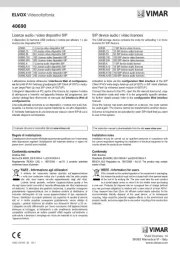
2 September 2025
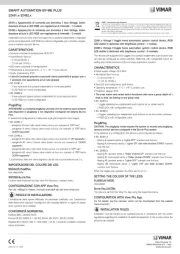
26 Augustus 2025
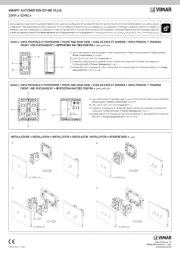
26 Augustus 2025
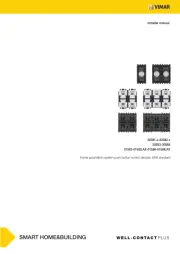
26 Augustus 2025
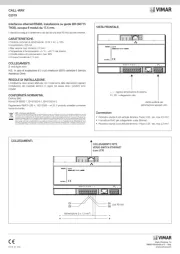
14 Augustus 2025
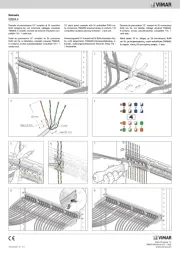
5 Juli 2025
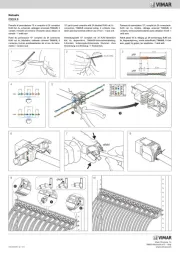
5 Juli 2025
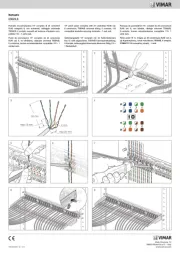
5 Juli 2025

5 Juli 2025
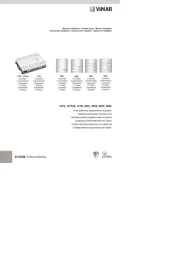
24 Mei 2025
Handleiding Niet gecategoriseerd
- Ambrogio
- Luminex
- Oasis
- Brastemp
- Fantastic
- Lantus
- API Audio
- Natec
- Nexxt
- Neve
- Thinkware
- Dual
- Pointer
- Brita
- Uplink
Nieuwste handleidingen voor Niet gecategoriseerd
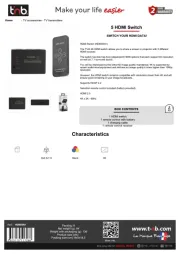
15 September 2025
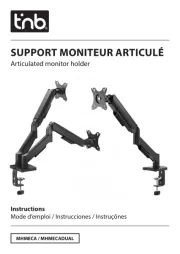
15 September 2025

15 September 2025
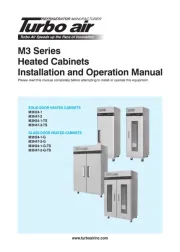
15 September 2025
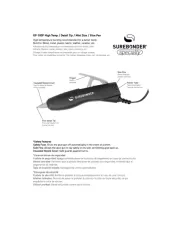
15 September 2025

15 September 2025

15 September 2025

15 September 2025
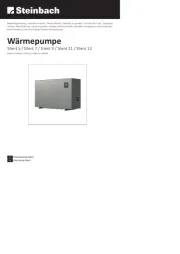
15 September 2025
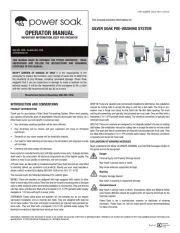
15 September 2025